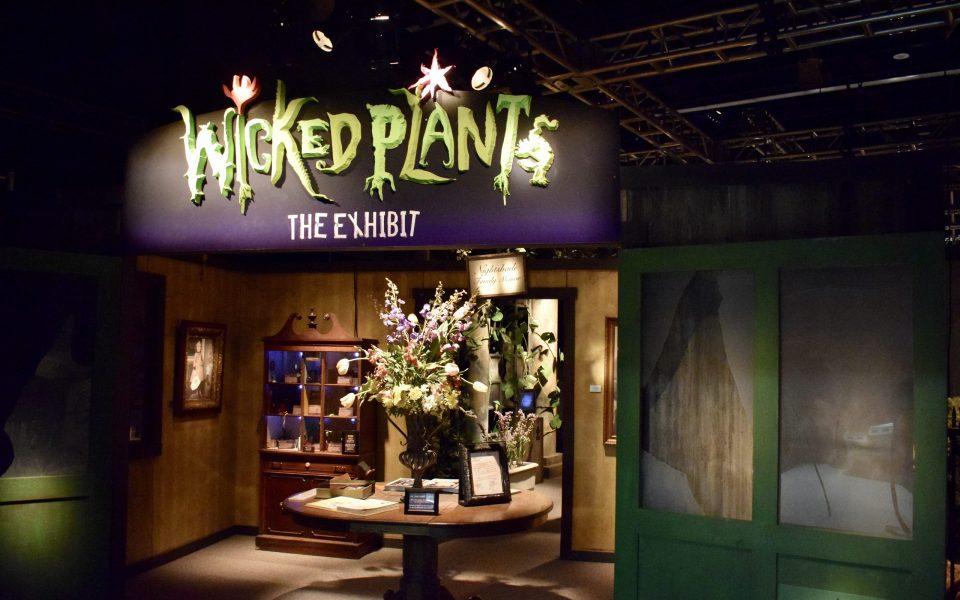Grisly realities of the natural world aren’t exactly hidden at the Greensboro Science Center but something downright sinister awaits guests in the museum wing’s newest exhibit, Wicked Plants: The Weed that Killed Lincoln’s Mother and Other Botanical Atrocities.
It’s no shock to most that some plants carry toxic potential, but Wicked Plants exposes the seemingly innocent species — the ones we welcome into our homes. And that’s at least partly why the exhibit is set up in a labyrinth of dimly lit, Victorian-styled rooms, which properly amps up the space’s eerie subtext.
Visitors first enter “Nightshade Manor,” a room dedicated to a family of 60 species known for branched hairs and thorns, classified as nightshades because of the amnesia-like state some of the plants cause when ingested or otherwise absorbed. Tobacco is among them — nicotine is technically a neurotoxin, much to the detriment of those generations back who chewed the old cash crop raw only to experience cramps, difficulty breathing, seizures and, eventually, death.

©
The multiplicity of species would overwhelm if not for stops at interactive displays that slow down the pace with accessible text to read, knobs to push and pull, and recordings for listening. Whether or not you enjoy the house-of-horrors trope, inherent value exists in the introduction to basic theories of biological sciences, like coevolution; some plants and animals evolved ways of warning other creatures they are poisonous, and peering into a thoroughly vintage cabinet will walk viewers through the warning signals. It would be easy to spend upwards of two hours moseying about, experiencing that innate human reverence for and fear of nature.
Wicked Plants weaves history, linguistics, chemistry, botany and medicine together for a holistic and, frankly, charming education on the subject — there’s even a room dedicated to psychedelic substances, as good for learning as for trading experiences. Many stories on the wall harken back to the Romans or further, like their experimentation with henbane for numbing people undergoing surgery. Yellowed, 19th Century newspaper stories speak to the popular culture of the time, and the making of urban legends appear in several spaces, especially in the case of aristocratic Anglo women, once known to use the toxic belladonna in eye drops to dilate their pupils to appear more seductive. (Rumors that the wives of Roman Emperor Augustus and Claudius wielded the toxic herb as murder weapons still circulate.)
Another unconfirmed — and unlikely — murder weapon is situated in a glass case toward the back left of the exhibit: a tan-colored umbrella allegedly employed to poke the thigh of Georgi Markov, a journalist and defector from communist Bulgaria in 1978, injecting ricin into his bloodstream. The poison, derived from castor bean plants and a major plot point in the show “Breaking Bad,” provoked a fever as Markov struggled to speak and vomited blood for hours before dying in the hospital.

©
Nettles’ lethality doesn’t require human intervention, though — its fine hairs act as hypodermic needles to secrete muscle toxins and acids under the skin, including formic acid, an element of ant and bee venom. Their family name, urticaceae, derives from urticarial, the medical term for intense, painful hives.
The onslaught of unnerving side effects is far more grotesque than the laundry list for most contemporary prescription medication: delirium unto death, excruciating blisters and boils or, the worst, de facto mummification, which could result from imbibing a poisonous lacquer tea made of Urushi tree sap.
Though the Victorian-era feel allows some psychological distancing, Wicked Plants reminds us that nature provided the first medicine. And also, our first poisons.
Join the First Amendment Society, a membership that goes directly to funding TCB‘s newsroom.
We believe that reporting can save the world.
The TCB First Amendment Society recognizes the vital role of a free, unfettered press with a bundling of local experiences designed to build community, and unique engagements with our newsroom that will help you understand, and shape, local journalism’s critical role in uplifting the people in our cities.
All revenue goes directly into the newsroom as reporters’ salaries and freelance commissions.


Leave a Reply